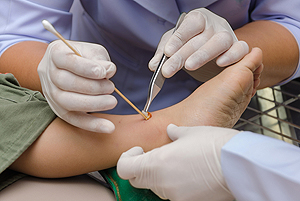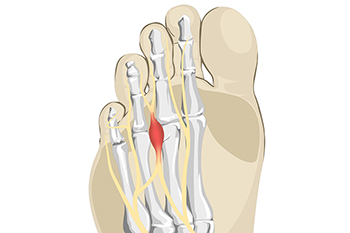 While most of the time ankle pain generates from an injury, it sometimes occurs without an obvious incident you can pin point it back to. Ankle pain can actually occur due to a variety of underlying causes that you may not have considered, including arthritis. The 3 types of arthritis that primarily affects the ankles are osteoarthritis (where the cartilage between the bones begins to wear away), rheumatoid arthritis (an autoimmune disorder that causes the immune system to attack healthy joints), or reactive arthritis (which is caused by a bacterial infection in another part of the body). Other various conditions, such as gout, fallen arches, a bone or joint infection, bursitis, or even lupus can lead to unexplainable ankle pain. If you have ankle pain, consulting with a podiatrist for a proper diagnosis is highly suggested. Upon diagnosis, a podiatrist will also be able to help suggest treatment options for your specific condition.
While most of the time ankle pain generates from an injury, it sometimes occurs without an obvious incident you can pin point it back to. Ankle pain can actually occur due to a variety of underlying causes that you may not have considered, including arthritis. The 3 types of arthritis that primarily affects the ankles are osteoarthritis (where the cartilage between the bones begins to wear away), rheumatoid arthritis (an autoimmune disorder that causes the immune system to attack healthy joints), or reactive arthritis (which is caused by a bacterial infection in another part of the body). Other various conditions, such as gout, fallen arches, a bone or joint infection, bursitis, or even lupus can lead to unexplainable ankle pain. If you have ankle pain, consulting with a podiatrist for a proper diagnosis is highly suggested. Upon diagnosis, a podiatrist will also be able to help suggest treatment options for your specific condition.
Ankle pain can be caused by a number of problems and may be potentially serious. If you have ankle pain, consult with one of our podiatrists from Westside Podiatry Center, LLP. Our doctors will assess your condition and provide you with quality foot and ankle treatment.
Ankle pain is any condition that causes pain in the ankle. Due to the fact that the ankle consists of tendons, muscles, bones, and ligaments, ankle pain can come from a number of different conditions.
Causes
The most common causes of ankle pain include:
- Types of arthritis (rheumatoid, osteoarthritis, and gout)
- Ankle sprains
- Broken ankles
- Achilles tendinitis
- Achilles tendon rupture
- Stress fractures
- Bursitis
- Tarsal tunnel syndrome
- Plantar fasciitis
Symptoms
Symptoms of ankle injury vary based upon the condition. Pain may include general pain and discomfort, swelling, aching, redness, bruising, burning or stabbing sensations, and/or loss of sensation.
Diagnosis
Due to the wide variety of potential causes of ankle pain, podiatrists will utilize a number of different methods to properly diagnose ankle pain. This can include asking for personal and family medical histories and of any recent injuries. Further diagnosis may include sensation tests, a physical examination, and potentially x-rays or other imaging tests.
Treatment
Just as the range of causes varies widely, so do treatments. Some more common treatments are rest, ice packs, keeping pressure off the foot, orthotics and braces, medication for inflammation and pain, and surgery.
If you have any questions, please feel free to contact one of our offices located in Liverpool, Camillus, Skaneateles, Oswego, and Cicero, NY . We offer the newest diagnostic and treatment technologies for all your foot care needs.



 a
a
